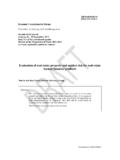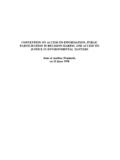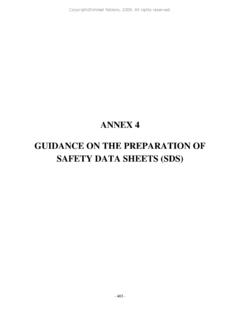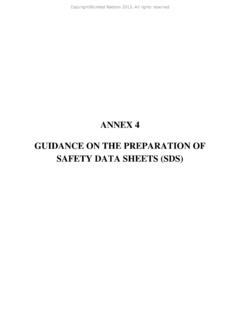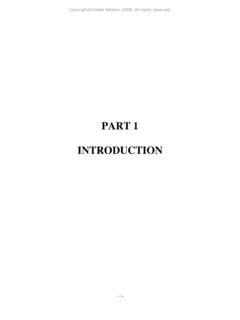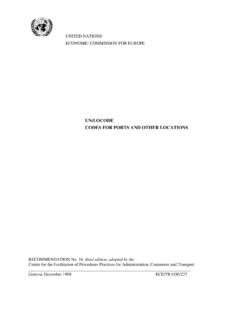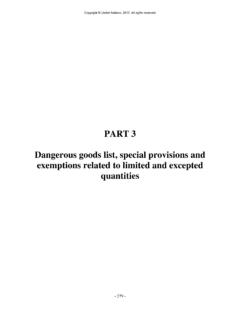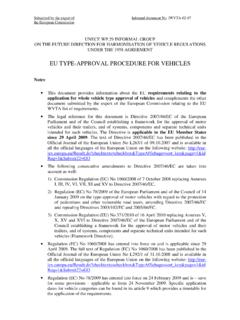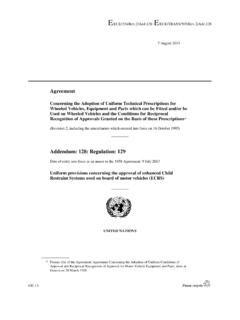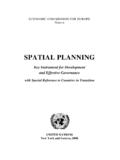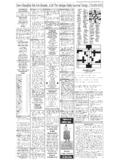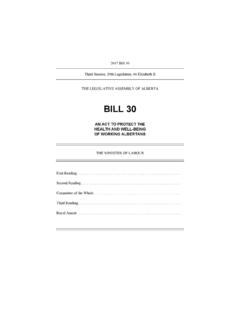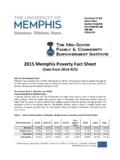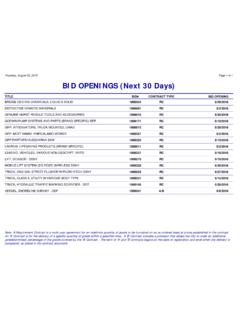Transcription of CONCERNING THE ADOPTION OF UNIFORM …
1 E/ECE/324 E/ECE/TRANS/505} 29 March 2007 AGREEMENT CONCERNING THE ADOPTION OF UNIFORM TECHNICAL PRESCRIPTIONS FOR WHEELED VEHICLES, EQUIPMENT AND PARTS WHICH CAN BE FITTED AND/OR BE USED ON WHEELED VEHICLES AND THE CONDITIONS FOR RECIPROCAL RECOGNITION OF APPROVALS GRANTED ON THE BASIS OF THESE PRESCRIPTIONS / (Revision 2, including the amendments which entered into force on 16 October 1995) _____ Addendum 29: Regulation No. 30 Revision 3 Incorporating all valid text up to: Supplement 10 to the 02 series of amendments - Date of entry into force: 13 January 2000 Corrigendum 1 to Supplement 10 to the 02 series of amendments, subject of Depositary Notification dated 13 May 2004 Supplement 11 to the 02 series of amendments - Date of entry into force: 28 December 2000 Supplement 12 to the 02 series of amendments - Date of entry into force: 20 February 2002 / Corrigendum 1 to Supplement 12 to the 02 series of amendments, subject of Depositary Notification dated 1 August 2002 (English and Russian only) Supplement 13 to the 02 series of amendments - Date of entry into force: 26 February 2004 Supplement 14 to the 02 series of amendments - Date of entry into force.
2 18 January 2006 UNIFORM PROVISIONS CONCERNING THE APPROVAL OF PNEUMATIC TYRES FOR MOTOR VEHICLES AND THEIR TRAILERS _____ UNITED NATIONS / Former title of the Agreement: Agreement CONCERNING the ADOPTION of UNIFORM Conditions of Approval and Reciprocal Recognition of Approval for Motor Vehicle Equipment and Parts, done at Geneva on 20 March 1958. / For New Zealand, the entry into force is 20 April 2002. E/ECE/324 E/ECE/TRANS/505} Regulation No. 30 page 3 Regulation No. 30 UNIFORM PROVISIONS CONCERNING THE APPROVAL OF PNEUMATIC TYRES FOR MOTOR VEHICLES AND THEIR TRAILERS CONTENTS REGULATION Page 1. 5 2.
3 Definitions .. 5 3. Markings .. 12 4. Application for 14 5. Approval .. 15 6. Requirements .. 16 7. Modifications of the type of pneumatic tyre and extension of 21 8. Conformity of production .. 21 9. Penalties for non-conformity of production .. 21 10. Production definitively 22 11. Transitional provisions .. 22 12. Names and addresses of Technical Services responsible for conducting approval tests and of Administrative Departments .. 22 ANNEXES Annex 1 - Communication CONCERNING the approval or extension or refusal or withdrawal of approval or production definitely discontinued of a type of pneumatic tyre for motor vehicles pursuant to Regulation No. 30 Annex 2 - Example of the arrangement of the approval mark Annex 3 - Arrangement of tyre markings Annex 4 - Load-capacity indices E/ECE/324 E/ECE/TRANS/505 } Regulation No.
4 30 page 4 CONTENTS (continued) Annex 5 - Tyre size designation and dimensions Annex 6 - Method of measuring pneumatic tyres Annex 7 - Procedure for load/speed performance tests E/ECE/324 E/ECE/TRANS/505} Regulation No. 30 page 5 1. SCOPE This Regulation covers new pneumatic tyres designed primarily, but not only, for vehicles in categories M1, O1 and O2. 1/ It does not apply to tyres designed for (a) the equipment for vintage cars (b) competitions. 2. DEFINITIONS For the purposes of this Regulation, "Type of pneumatic tyre" means a category of pneumatic tyres which do not differ in such essential respects as: The manufacturer; Tyre-size designation; Category of use (ordinary (road-type) or snow tyre or for temporary use); Structure (diagonal (bias-ply), bias-belted, radial-ply, run flat tyre); Speed category symbol; Load-capacity index; Tyre cross-section; "Snow tyre" means a tyre whose tread pattern and whose structure are primarily designed to ensure in mud and fresh or melting snow a performance better than that of an ordinary (road-type) tyre.
5 The tread pattern of a snow tyre generally consists of groove (rib) and/or solid-block elements more widely spaced than on an ordinary (road-type) tyre; "Structure" of a pneumatic tyre means the technical characteristics of the tyre's carcass. The following structures are distinguished in particular; 1/ As defined in Annex 7 to the Consolidated Resolution on the Construction of Vehicles ( ), (document as last amended by ). E/ECE/324 E/ECE/TRANS/505 } Regulation No. 30 page 6 "Diagonal" or "bias-ply" describes a pneumatic-tyre structure in which the ply cords extend to the beads and are laid at alternate angles of substantially less than 90 to the centre line of the tread; "Bias-belted" describes a pneumatic-tyre structure of diagonal (bias-ply) type in which the carcass is restricted by a belt comprising two or more layers of substantially inextensible cord material laid at alternate angles close to those of the carcass; "Radial" describes a pneumatic-tyre structure in which the ply cords extend to the beads and are laid substantially at 90 to the centre line of the tread, the carcass being stabilized by an essentially inextensible circumferential belt.
6 "Reinforced" or "Extra Load" describes a pneumatic-tyre structure in which the carcass is more resistant than that of the corresponding standard tyre; "Temporary use spare tyre" means a tyre different from a tyre intended to be fitted to any vehicle for normal driving conditions but intended only for temporary use under restricted driving conditions; "T-type temporary use spare tyre" means a type of temporary use spare tyre designed for use at inflation pressures higher than those established for standard and reinforced tyres; "Run flat tyre" or "Self supporting tyre" describes a pneumatic tyre structure provided with any technical solutions (for example, reinforced sidewalls, etc.) allowing the pneumatic tyre, mounted on the appropriate wheel and in the absence of any supplementary component, to supply the vehicle with the basic tyre functions, at least, at a speed of 80km/h (50mph) and a distance of 80km when operating in flat tyre running mode.
7 "Bead" means the part of a pneumatic tyre which is of such shape and structure as to fit the rim and hold the tyre on it; 2/ "Cord" means the strands forming the fabric of the plies in the pneumatic tyre; 2/ "Ply" means a layer of rubber-coated parallel cords; 2/ "Carcass" means that part of a pneumatic tyre other than the tread and the rubber side walls which, when inflated, bears the load; 2/ "Tread" means that part of a pneumatic tyre which comes into contact with the ground; 2/ 2/ See explanatory figure. E/ECE/324 E/ECE/TRANS/505} Regulation No. 30 page 7 "Side wall" means the part of a pneumatic tyre between the tread and the bead; 2/ "Lower area of tyre" means the area included between the point of maximum section width of the tyre and the area designed to be covered by the edge of the rim; 2/ However, in case of tyres identified by the "tyre to rim fitment configuration" (see para.)
8 Symbol "A", it means the area of the tyre which is seating on the rim. "Tread groove" means the space between two adjacent ribs or blocks in the tread pattern; 2/ "Section width" means the linear distance between the outsides of the side walls of an inflated pneumatic tyre, excluding elevations due to labelling (marking), decoration or protective bands or ribs; 2/ "Overall width" means the linear distance between the outsides of the side walls of an inflated pneumatic tyre, including labelling (marking), decoration and protective bands or ribs; 2/ "Section height" means a distance equal to half the difference between the outer diameter of the tyre and the nominal rim diameter; 2/ "Nominal aspect ratio (Ra)" means the centuple of the number obtained by dividing the number expressing the section height in mm by the number expressing the nominal section width in mm; "Outer diameter" means the overall diameter of an inflated new pneumatic tyre; 2/ "Tyre-size designation" is a designation showing: the nominal section width.
9 This width must be expressed in mm, except in the case of the types of tyre for which the size designation is shown in the first column of the tables in Annex 5 to this Regulation; the nominal aspect ratio except in the case of certain types of tyre, for which the size designation is shown in the first column of the tables in Annex 5 to this Regulation, or, depending on the tyre design type, the nominal outer diameter expressed in mm; _____ 2/ See explanatory figure. E/ECE/324 E/ECE/TRANS/505 } Regulation No. 30 page 8 a conventional number denoting the nominal rim diameter and corresponding to its diameter expressed either by codes (numbers below 100) or in millimetres (numbers above 100); the letter "T" in front of the nominal section width in case of T-type temporary use spare tyres; an indication of the tyre to rim fitment configuration when it differs from the standard configuration.
10 "Nominal rim diameter" means the diameter of the rim on which a tyre is designed to be mounted; "Rim" means the support for a tyre-and-tube assembly, or for a tubeless tyre, on which the tyre beads are seated; 2/ "Tyre to rim fitment configuration" means the type of rim to which the tyre is designed to be fitted. In the case of non-standard rims this will be identified by a symbol applied to the tyre, for example, "CT", "TR", "TD" or "A". "Theoretical rim" means the notional rim whose width would be equal to x times the nominal section width of a tyre. The value of x shall be specified by the manufacturer of that tyre; "Measuring rim" means the rim on which a tyre is required to be fitted for size measurements; "Test rim" means the rim on which a tyre is required to be fitted for testing; "Chunking" means the breaking away of pieces of rubber from the tread; "Cord separation" means the parting of the cords from their rubber coating; "Ply separation" means the parting of adjacent plies; "Tread separation" means the pulling away of the tread from the carcass; "Tread-wear indicators" means the projections within the tread grooves designed to give a visual indication of the degree of wear of the tread; _____ 2/ See explanatory figure.
